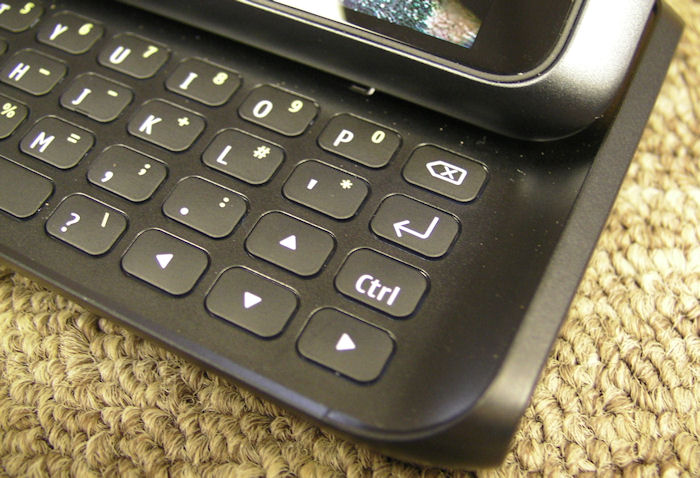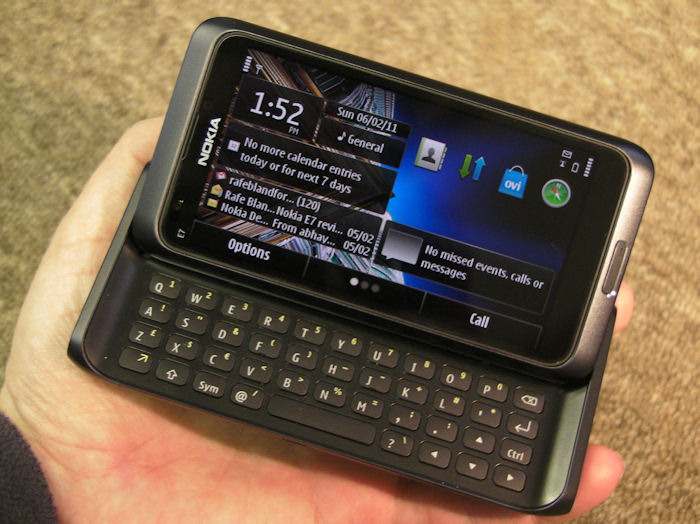
So one device to rule them all? Well, not quite, but in this case the E7 promised to be the best fit for me for handling all my smartphone needs, in fact for handling all my 'wish I'd brought a laptop' needs as well. I've been over the E7's design compromises before, so I won't rehash the same text - suffice it to say that the smallish internal 1200mAh battery is a disappointment and I'll comment on that further below. The EDoF camera is an acquired taste but generally works very well. And the lack of memory expansion ultimately stops this device from being a multimedia powerhouse - or maybe that's down to the battery too?
My 48 hours away would deliver a verdict, anyway.
Lofty highs
I have to start with a few huge positives. The E7's display - 4" and CBD (ClearBlackDisplay) technology - it's a modern miracle and only the Samsung Galaxy S II's Super AMOLED screen comes remotely close to the colours, detail and clarity. It's just superb for displaying text, images, maps - or videos. I've done tests against other mobile devices from all OS persuasions, comparing the same videos in darkened rooms under identical circumstances, and the Nokia E7 knocks almost all of them into a cocked hat. With the angled up screen in 'opened' mode, the E7 really is almost the perfect video companion and I took away four feature films (about 1.5GB each) and my usual complement of another Gig of assorted music videos.
When showing friends and relatives photos I'd taken, the E7 screen is brilliant - several non-geeks commented specifically on how clear it was compared to anything they'd ever seen before. Praise indeed. And - this is going to sound incredibly fanboy-ish - I'm even impressed by the E7 display when it's turned off. With its CBD polarising technology, light just seems to sink into it, it's like peering into the abyss....
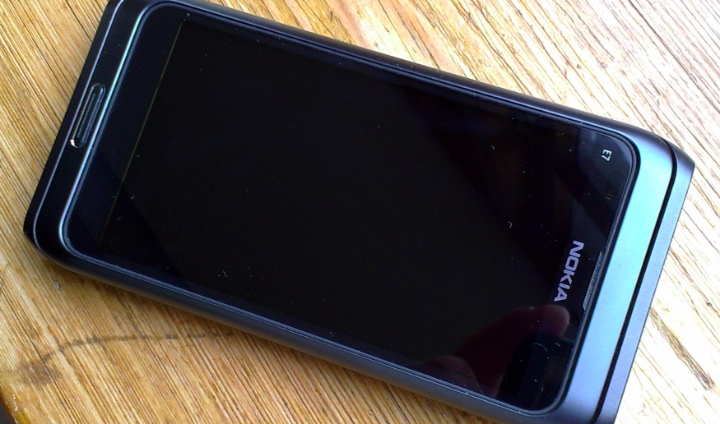
The only area where the Symbian nHD resolution is a potential problem is in browsing Web pages, where you have to zoom in to a fair degree to read all text, where on the likes of the HTC Sensation or Motorola Atrix (with qHD resolution) you can, with good enough eyes, work zoomed out quite a bit more. (The relative slowness of the browser itself is something fixed in Anna - see below)
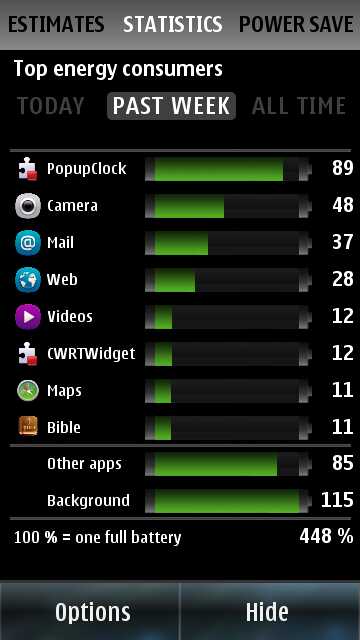 One curiosity is that the Nokia E7 ships with the 'Settings>Display>Themes>Screen saver' set to 'none', rather than the rather useful always-on OLED clock seen on the other Symbian^3 devices. At first I thought this was a setup bug and that Nokia had meant to ship it with the default as 'on', but after much use I've noted, as shown on the left, that one of the single biggest power hogs in the device, measured on a day to day basis, is 'Pop up clock', a reference to this screen saver.
One curiosity is that the Nokia E7 ships with the 'Settings>Display>Themes>Screen saver' set to 'none', rather than the rather useful always-on OLED clock seen on the other Symbian^3 devices. At first I thought this was a setup bug and that Nokia had meant to ship it with the default as 'on', but after much use I've noted, as shown on the left, that one of the single biggest power hogs in the device, measured on a day to day basis, is 'Pop up clock', a reference to this screen saver.
Evidently, the physical display of the clock on the 4" (i.e. large) CBD screen uses more power than on the smaller screened N8 and C7 - I guess it's the larger OLED pixels, throwing out more light. In any case, I've now disabled the 'Screen saver' again and am enjoying a small boost of 10% or so each day on battery life - of which more below.
The keyboard has been much praised too, and with good reason. The key spacing and 'feel' is just superb for texting, emailing, tweeting, even writing small documents, despite the relatively small travel. I mainly used the E7 in two hands, thumb typing, but it's usable on the desk two, with index fingers. The layout of the 'fn' and 'Ctrl' keys has been much criticised but in a keyboard this size, there have to be some compromises. Once you get used to Ctrl being on the right, it's actually easier to use, with one thumb on Ctrl and the other on 'x' or 'c' etc. Fn and shift might have been swapped, but that's just my opinion, it's certainly not a showstopper.
While on the subject of key layout, I've figured out the bizarre placing of the E7's 'home'/Menu button. It makes zero sense in portrait mode, as the button seems wrong for both left and right handers, plus it seems too stiff. But open the E7 up and hold it in the traditional 'two handed' mode and the button is in the perfect place for the right thumb - and is no longer too stiff, because the thumb is strong and has plenty of leverage. Please note I'm not being a Nokia apologist here, I'm just getting inside the E7 designer's head.
Also positive, on the whole, has been the E7's camera. I took around 50 photos in the 48 hours and was pleased with almost all of them. None were of 'macro' subjects and so EDoF was perfectly fine, snapping people, scenery and (ahem) steam trains with equal ease. With no focussing, you can literally hold up the phone and press the shutter without taking any care whatsoever and the results come back great. It's a subject I've covered before and the only real objection, as ever, on the E7, is that a business user would want to shoot macro subjects in the office. A debate that will run and run....
Video capture worked brilliantly too, regular readers will know that I use the E7 to shoot my Phones Show in preference to even the N8, and the handful of videos I snapped in this 48 hours also turned out crisp and clear.
One of the other common criticisms of the E7 is its integral 16GB capacity, i.e. you can't expand its storage memory using a microSD card. Is this a problem out in the real world? Possibly. It's certainly not a showstopper. With a few films, plus other videos, plus around 30 to 40 albums of music, plus room for captured images, podcasts, maps and more in the internal disk, it should be noted that 16GB is actually quite a lot (I remember buying my first memory card, a 128k - yes, KILOBYTES - SSD for my Psion palmtop, back in 1994...!) Yes, the hard limit means that you can't put all your media on the device, you will have to pick and choose quite a bit.
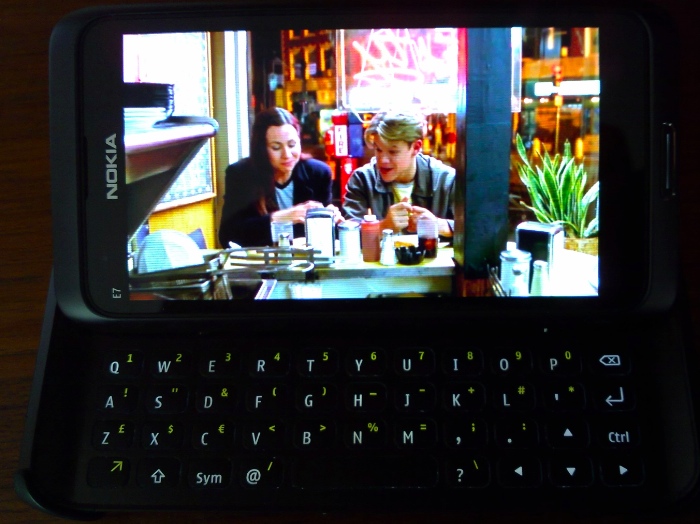
Nokia will point to being able to plug in a USB memory stick via USB on the go, to access extra media, but as many have pointed out, this just doesn't work in practice. You're then using up the one port which absolutely, vitally, crucially, is needed to overcome the E7's single biggest flaw, its lowest point and one which I'm reminded of almost every time I pick the device up.
Battery life.
Deep lows
The reason you can't leave a USB memory stick plugged in is that you need the port for a charger (or data/charging) lead, to power the E7. With a 1200mAh battery that's not user accessible, the big-screened E7 is appallingly specified in this department. What's need for this form factor and general 'mini laptop' use case is a replaceable cell of 1500mAh or more. Now that would have inspired confidence. Instead, we've got an integral cell that can't be swapped or replaced by anyone other than a Nokia Care Point. Yes, the iPhone 4 has an integral battery, but it's a bigger in capacity, at 1450mAh, and rumoured to be Li-Polymer. The E7, in normal phone and email use, will get you through the day, but the wonderfully clear screen cries out for media use and the battery's just not up to the task of powering video playback (or gaming, or image browsing) for extended periods. Do so and you'll be in 'power saving mode' by tea-time, guaranteed.
In my 48 hour test period, I found myself mesmerised by the dropping figure on my homescreen 'Nokia Battery Monitor' widget. Each day, I'd be down to well under 20% by tea-time and felt the need to give the E7 a 'top up charge' to get me through the evening and night (am I the only one who listens to podcasts in bed?)
Which isn't really acceptable, a day-long period of moderately heavy use should be possible on any smartphone, I contend. In practice, the E7 owner learns to keep a charger on hand in the office, at home, in the car, and at each convenient point to give the device a precious charge boost. With such hand-holding, the E7 is fine, but just bear in mind that this is no direct E90 replacement. You've got to think very carefully about where you'll use the E7, what facilities will be available, what charging tips, and so on.
All of which rather dents my overall impression of the E7 as a day to day smartphone.
Talking of dents - or rather lack of them - I can't let this article pass without comment on the E7's construction. And on its droppability. You see, the unibody aluminium construction sounds wonderful in practice. Both it and the steel pivot mechanism are immensely strong. And fondling the E7 in closed mode, as a reviewer in an office, you're struck by how smooth and polished it is. But then you take it out into the world.
And you drop it. Several times. Even more so than the super-slippery N8, the E7 sits in the hand like a bar of wet soap and is almost as droppable. Which isn't what you want when trying to check something on it while holding shopping or a kid's hand or a knap-sack or whatever you get up to when youre not at work.
Thankfully the E7 seems robust, as evidenced by mine still working, but what's needed is a shroud to make it grippier but without adding bulk or getting in the way. I've reviewed a number of E7 cases but have settled on the CC-3009, which only adds a couple of millimetres in thickness and yet adds lots of grip (in the hand and on the desk) and also protects the vulnerable camera glass. Recommended.
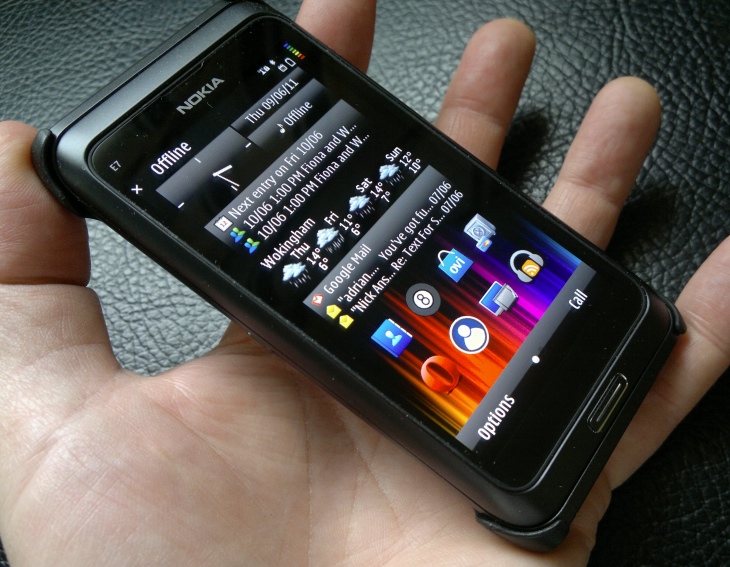
I'm normally one of the biggest advocates for metal construction in smartphones, but in the N8 and E7, Nokia went too far - I really wish a few stripes of plastic or rubber had been added, to break up the slippery metal hull.
More lows - software stability
Of all the Symbian^3 generation of smartphones, the E7's software build has seemed the most unstable - perhaps not surprising given the need for customisations for the hardware qwerty keyboard. I've had the Camera application regularly crash on me requiring an E7 restart and I've been plagued by a wi-fi bug that sees downloads over WPA2 networks get interrupted repeatedly, making gathering podcasts or downloading music almost impossible.
All of which isn't good. I'm pinning my hopes on Symbian Anna, due to go live for these older Symbian^3 phones very soon. Surely, surely, some of these instabilities will have been long since fixed? If Anna comes and goes with the bugs still in place then it'll be time to consign the E7 to the 'interesting but flawed' scrapheap of Symbian history, along with the N93 and E90. If (and I'm optimistic that this is the case) Anna fixes things under the hood then, battery worries aside, then the E7 gets seriously interesting as a mobile computer.
A mini laptop in your pocket
Despite repeated assertions in the popular tech press that Symbian is archaic and convoluted, I still prefer much about Symbian's UI to the competition. The customisable, nested folders of app shortcuts, for example. Ridiculed at first by the iPhone and Android camps, these were then retrofitted to iOS and now to some flavours of Android. Imitation, it seems.... etc.
I also quite like the Symbian widgetised homescreen system, giving me a great 'everything in one glance' display without having to swipe between five, seven or even nine homescreens on the likes of Android. Plus you may remember that iOS doesn't have a homescreen at all - yet.
And, in the E7's case, all this comes together beautifully in opened out, mini-laptop mode. Holistically, it feels miles away from the touch-only portrait slabs of the current age and is, perhaps, to be celebrated as such, despite the device's flaws. For the old-time Psion palmtop owner, for the Nokia Communicator owner, for the netbook owner wanting to travel even lighter, the E7 still has enough to gather interest, at least.
And so I for one am glad that Nokia had the courage to make a Symbian^3 phone in this mini-laptop form factor, despite the compromises - at least there is an option for those that want it, even if you do have to have a charger of some kind with you all the time....
Steve Litchfield, All About Symbian, 16 August 2011
